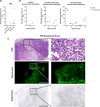Rapid Assessment of Bio-distribution and Antitumor Activity of the Photosensitizer Bremachlorin in a Murine PDAC Model: Detection of PDT-induced Tumor Necrosis by IRDye® 800CW Carboxylate, Using Whole-Body Fluorescent Imaging
- PMID: 38890241
- PMCID: PMC11281978
- DOI: 10.1007/s11307-024-01921-1
Rapid Assessment of Bio-distribution and Antitumor Activity of the Photosensitizer Bremachlorin in a Murine PDAC Model: Detection of PDT-induced Tumor Necrosis by IRDye® 800CW Carboxylate, Using Whole-Body Fluorescent Imaging
Abstract
Photodynamic therapy (PDT) is a light-based anticancer therapy that can induce tumor necrosis and/or apoptosis. Two important factors contributing to the efficacy of PDT are the concentration of the photosensitizer in the tumor tissue and its preferential accumulation in the tumor tissue compared to that in normal tissues. In this study, we investigated the use of optical imaging for monitoring whole-body bio-distribution of the fluorescent (660 nm) photosensitizer Bremachlorin in vivo, in a murine pancreatic ductal adenocarcinoma (PDAC) model. Moreover, we non-invasively, examined the induction of tumor necrosis after PDT treatment using near-infrared fluorescent imaging of the necrosis avid cyanine dye IRDye®-800CW Carboxylate. Using whole-body fluorescence imaging, we observed that Bremachlorin preferentially accumulated in pancreatic tumors. Furthermore, in a longitudinal study we showed that 3 hours after Bremachlorin administration, the fluorescent tumor signal reached its maximum. In addition, the tumor-to-background ratio at all-time points was approximately 1.4. Ex vivo, at 6 hours after Bremachlorin administration, the tumor-to-muscle or -normal pancreas ratio exhibited a greater difference than it did at 24 hours, suggesting that, in terms of efficacy, 6 hours after Bremachlorin administration was an effective time point for PDT treatment of PDAC. In vivo administration of the near infrared fluorescence agent IRDye®-800CW Carboxylate showed that PDT, 6 hours after administration of Bremachlorin, selectively induced necrosis in the tumor tissues, which was subsequently confirmed histologically. In conclusion, by using in vivo fluorescence imaging, we could non-invasively and longitudinally monitor, the whole-body distribution of Bremachlorin. Furthermore, we successfully used IRDye®-800CW Carboxylate, a near-infrared fluorescent necrosis avid agent, to image PDT-induced necrotic cell death as a measure of therapeutic efficacy. This study showed how fluorescence can be applied for optimizing, and assessing the efficacy of, PDT.
Keywords: Bremachlorin; Fluorescence; Necrosis; Optical imaging; PDAC; PDT; PS; Photodynamic therapy; Photosensitizer; Whole-body imaging.
© 2024. The Author(s).
Conflict of interest statement
The authors declare that they have no relevant conflicts of interest.
Figures





Similar articles
-
Combination of Bremachlorin PDT and Immune Checkpoint Inhibitor Anti-PD-1 Shows Response in Murine Immunological T-cell-High and T-cell-Low PDAC Models.Mol Cancer Ther. 2025 Apr 2;24(4):605-617. doi: 10.1158/1535-7163.MCT-23-0733. Mol Cancer Ther. 2025. PMID: 39704624 Free PMC article.
-
Microscopic analysis of the localization of two chlorin-based photosensitizers in OSC19 tumors in the mouse oral cavity.Lasers Surg Med. 2014 Mar;46(3):224-34. doi: 10.1002/lsm.22220. Epub 2014 Jan 16. Lasers Surg Med. 2014. PMID: 24436109
-
Measurement of Cyanine Dye Photobleaching in Photosensitizer Cyanine Dye Conjugates Could Help in Optimizing Light Dosimetry for Improved Photodynamic Therapy of Cancer.Molecules. 2018 Jul 24;23(8):1842. doi: 10.3390/molecules23081842. Molecules. 2018. PMID: 30042350 Free PMC article.
-
Core-shell polymeric nanoparticles co-loaded with photosensitizer and organic dye for photodynamic therapy guided by fluorescence imaging in near and short-wave infrared spectral regions.J Nanobiotechnology. 2020 Jan 23;18(1):19. doi: 10.1186/s12951-020-0572-1. J Nanobiotechnology. 2020. PMID: 31973717 Free PMC article.
-
Fluorescence- and multispectral optoacoustic imaging for an optimized detection of deeply located tumors in an orthotopic mouse model of pancreatic carcinoma.Int J Cancer. 2018 May 15;142(10):2118-2129. doi: 10.1002/ijc.31236. Epub 2018 Jan 19. Int J Cancer. 2018. PMID: 29277891
References
MeSH terms
Substances
Grants and funding
LinkOut - more resources
Full Text Sources
Medical

